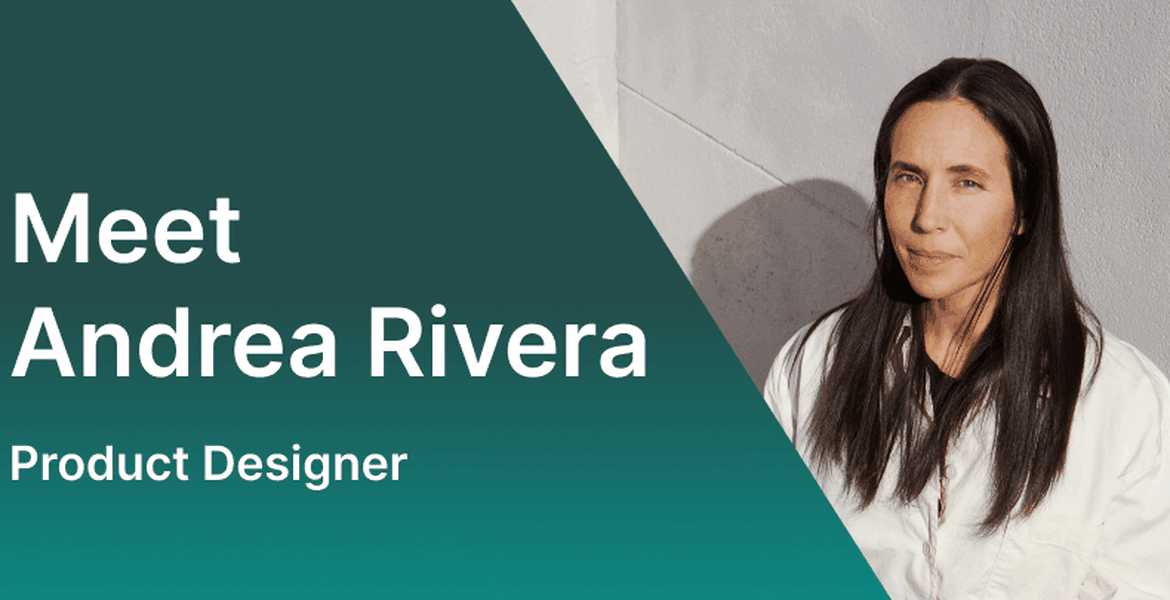
We sat down with Andrea Rivera Gomez, Product Designer for DEEPCRAFT™ Studio, to explore the dynamic world she works in. From navigating a non-traditional path into tech, to crafting user-centered experiences and implementing a full design system, this conversation offers insight into the creativity, challenges, and thoughtfulness that go into building cutting-edge AI tools.
Let’s start from the beginning, what is your role at Imagimob?
Andrea: I’m Imagimob’s first Product Designer. In essence I am responsible for the User Experience (UX), User Interface and integrating these strategies with the greater business strategy for DEEPCRAFT™ Studio.
It’s a job that requires you to think quickly and wear many hats; one moment you are focusing on journey mapping, the next you move on to some high-fidelity designs in Figma, and in between you are hallway testing and running user interviews to validate if those ideas are working.
What drew you to product design?
Andrea: I would say that product design found me. Before I moved to Sweden I had been working for agencies where I dabbled in application and software design, but my focus was more on branding and creating campaigns for ads.
However, I found the experiences around software design interesting because I could collaborate with engineers and work in fast, iterative sprints. When I started looking for work in Sweden, I kept getting calls back for product design roles and I guess it just made sense to try my luck with this role. Ten years later here I am, and I think even though it was a steep learning curve it was the right decision for me!
What was your path into tech like? Traditional? Non-traditional? Full of happy accidents?
Andrea: I’m not sure what a traditional path looks like, so I can’t say what that is like. So, I would say it was a path of happy accidents fueled by an interest in more democratic design practices and collaboration with people passionate about technology.
What’s your go-to approach when starting a new project or new design feature?
Andrea: My approach is curated for every project. I have a general design process I follow, but it is flexible depending on the constraints of the project. So sometimes I can just go from a quick outline of what those representative tasks or goals for the user are, straight to high-fidelity designs. Other times I spend more time wireframing solutions and testing them before jumping on to high-fidelity.
Regarding DEEPCRAFT™ Studio, my approach is to work organically with the product team, supporting the projects or features that have been prioritized by our business leaders. My approach is to start injecting some of the design systems thinking into the product as we update our product offerings.
What are you trying to bring to/change for DEEPCRAFT™ Studio users?
Andrea: I’m introducing a design system for DEEPCRAFT™ Studio users, and for me this is the biggest challenge because it means redesigning all the primitives and components that build an application. However, with this updated component library I plan to make the application more accessible and delightful for our users.
On the UX side, I’m bringing my expertise when we release new features so the team is centered on the user’s goals and on how to achieve them from the user’s perspective.
What is one update to update you’re most excited to have already implemented in DEEPCRAFT™ Studio?
Andrea: We have a lot of new and exciting features cooking right now, so it’s hard to choose from all the cool projects we have. But if I had to choose, I would say the new design system. I’m currently working on this, and looking forward to these design assets being released so the application has improved usability.
What’s the one thing that people misunderstand about the role of a Product Designer?
Andrea: Usually, people think a Product Designer is somebody who studied industrial design and might be creating things like furniture. I don’t know how to do any woodwork but I can surely create high-fidelity mocks of applications. Even though there are some product designers that come from an industrial design background, many of us come from traditional graphic design or human computer interaction backgrounds.
What’s a particularly tricky design problem you’ve solved recently and how did you approach it?
Andrea: Recently we worked on an unreleased feature that will allow users to import data into DEEPCRAFT™ Studio in a more user-friendly way. The problem was solved by ideating with our PM on some wireframed concepts, going through some iterations, to later on create high-fidelity interactive mockups that I could use to test with our team of Machine Learning engineers. Testing was crucial to validate that the solution was solving the problems that led to usability improvements.
What’s one tool you cannot live without?
Andrea: Figma and of course, now LLMs, so I can fast track my workflows.
One word to describe your style?
Andrea: In a few words, thoughtful, minimalistic and with a pinch of delight! Don’t forget that all those interactions, icons, illustrations and branding elements make an application more delightful to users.
Subscribe to our monthly newsletter to stay up-to-date on all the latest blogs, news, events, webinars and more from Imagimob.